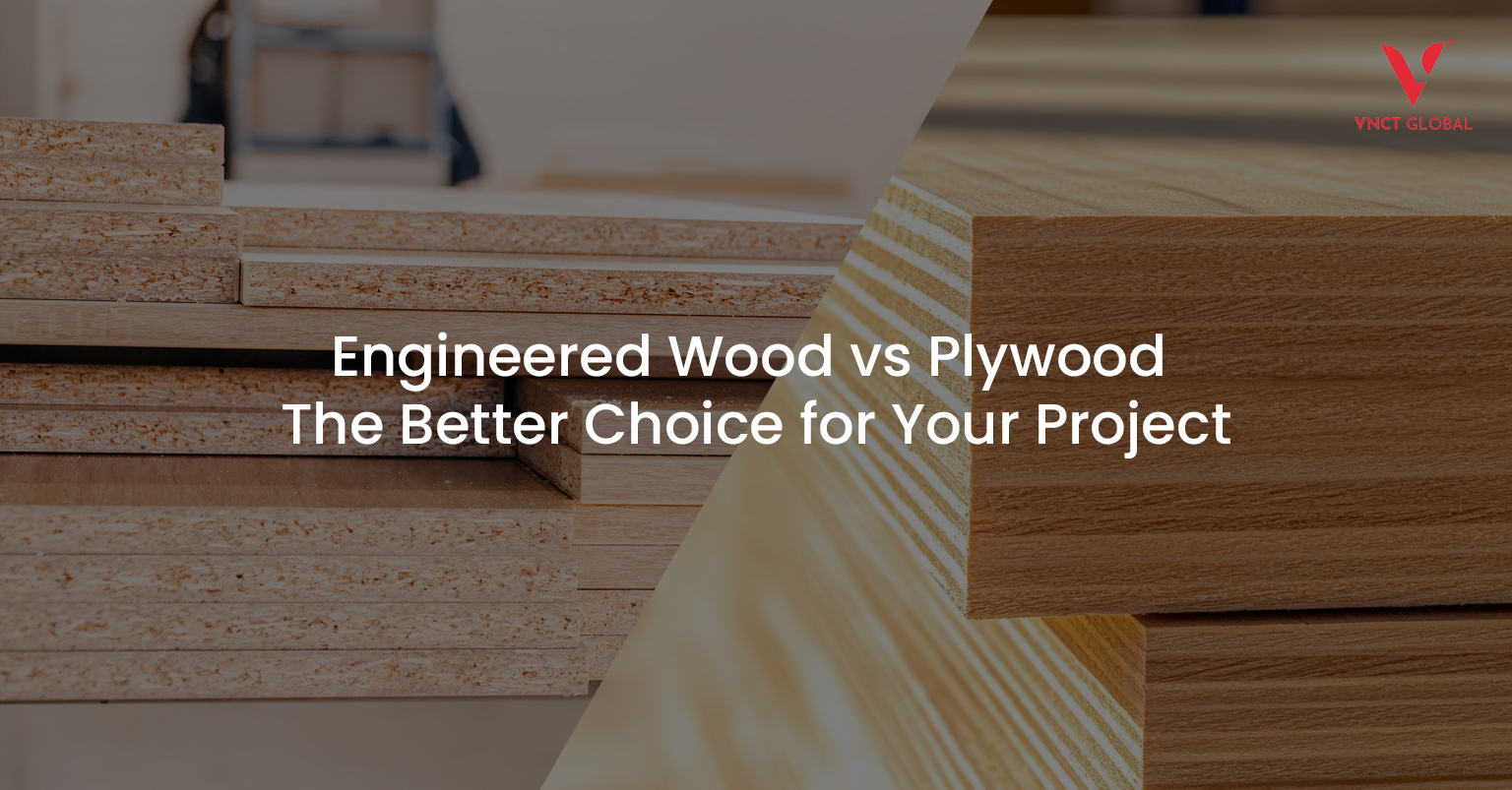Introduction
Engineered Wood vs Plywood — that’s the question many homeowners, developers, and NRI investors ask when planning interiors or structural elements. Choosing between these two can make a real difference in durability, aesthetics, cost, and long-term value. In this post, we’ll break down each material, compare them side by side, explore which works best under various conditions, and also talk specifically about how we at VNCT Global support NRI clients in villa projects whether it’s villas in Chennai, villas in Madurai, villas in Coimbatore, or landmark communities like Brookside Residences, Palm Beach, Creek Residences, Park Villas, or Ocean Drive Villas. We’ll also weave in mentions of best villa developers in India (repeated as requested) and largest villa developers in India, as you discover which wood fits your dream villa project best.
What is Engineered Wood?
Engineered wood (also called composite or manufactured wood) is made by combining wood fibers, wood strands, or veneers with adhesives, compressing them under heat and pressure to form panels or structural elements. It’s designed to give you a stable, uniform product that can be adapted for many applications.
Types of Engineered Wood
- MDF (Medium Density Fiberboard): Fine wood fibers bonded with resin, yielding a smooth surface ideal for painting
- HDF (High Density Fiberboard): Denser and stronger than MDF; used sometimes in flooring
- Particleboard: Made from wood chips and bits; cost-effective but weaker
- Blockboard / Blockboard core (sandwiched with veneers): A core of strips or blocks with veneer faces
- Veneer-faced engineered panels: Thin natural wood veneers over engineered cores
What is Plywood?
Plywood is also a form of engineered wood (in a broader sense) but built differently. It consists of thin wood veneer layers (plies) glued together. Each layer’s wood grain is oriented perpendicularly (or at differing angles) to improve strength, resist warping, and stabilize the board.
Types of Plywood You Should Know
- MR (Moisture Resistant) Plywood: For interior use, low moisture zones
- BWR / BWP (Boiling Water Resistant / Waterproof): Better for semi-wet zones like kitchens
- Marine Grade Plywood: Highly moisture-resistant, for bathrooms, exteriors
- Flexible Plywood: Thin sheets that can bend for curved surfaces
- Laminated / Decorative Plywood: With a decorative face layer for aesthetics
Composition: Engineered Wood vs Plywood
- Engineered Wood: Wood fibers, particles or veneers + adhesives, pressed into uniform boards.
- Plywood: Thin natural veneer sheets glued in alternating directions.
- Because of the cross-grain arrangement, plywood tends to resist splitting and warping better when subjected to stresses.
Strength and Durability
- Plywood generally wins in strength and durability, especially under heavier loads or structural use.
- Engineered wood like MDF or particleboard tend to chip or sag when overloaded.
- Some engineered products (e.g., high-quality blockboard, HDF) are better, but still often not at par with structural-grade plywood.
Water Resistance
- One of the biggest differentiators: plywood has variants (BWR, marine grade) built for wet or humid environments
- Engineered wood (especially MDF, particleboard) is more vulnerable to moisture it can swell, delaminate, or degrade.
Engineered Wood vs Plywood Price
- Engineered wood (MDF, particleboard) is typically cheaper than plywood.
- But high-end engineered panels (e.g. veneer-faced or specialty composites) may approach plywood costs.
- Over time, plywood may provide better value for money, because it lasts longer and can be refinished.
Surface Finish and Aesthetics
- Engineered wood gives a very smooth, uniform surface. It’s ideal for painted finishes or laminates.
- Plywood offers the natural grain and character of wood. You can stain or varnish it, and it feels more “authentic.”
- Some engineered boards are pre-laminated, saving time and finish costs.
Ease of Work: Engineered Wood Vs Plywood
- Engineered wood is generally easier to cut, machine, handle less chance of internal knots or voids.
- Plywood needs care poor-quality sheets may have internal voids or weak layers; edges must be sealed.
- However, plywood is more forgiving when sanding or refinishing over time.
Environmental Impact
- Many engineered wood products make use of recycled wood waste or fibers, reducing deforestation.
- But the adhesives and resins are a concern: formaldehyde emissions, VOCs — always choose low-emission or E0/E1 grades.
- Plywood, if sourced from sustainable forests, can be eco-friendly.
- In short: material quality, certifications, and manufacturing practices matter more than the board label.
Best Use Cases: Engineered Wood Vs. Plywood
Here’s when you might choose one over the other:
| Application | Better Choice | Reason |
| Structural elements (flooring joists, roofing, load-bearing parts) | Plywood | Better strength, cross-grain stability |
| Kitchen cabinets, bathrooms, wet zones | Plywood (BWR, marine) | Better moisture resistance |
| Interior furniture (shelves, wardrobes, wardrobes) | Engineered wood or plywood | For budget, engineered is fine; for longevity, plywood preferred |
| Decorative panels, painted surfaces | Engineered wood | Smooth, uniform surface works well |
| Modular or ready-to-assemble furniture | Engineered wood | Lightweight and consistent |
Pros and Cons at a Glance
Engineered Wood
| Pros | Cons |
| Lower cost | Not as strong under heavy load |
| Smooth, uniform surfaces, easy to finish | Vulnerable to moisture damage |
| Easier to cut and handle | Cannot always be refinished or sanded deeply |
| Uses recycled wood material | Quality depends heavily on adhesives and manufacturing |
Plywood
| Pros | Cons |
| High strength and stability | Higher initial cost |
| Better moisture resistance (with correct grade) | Heavier to transport/handle |
| Can be refinished over time | Lower grades may have internal voids or defects |
| Visual appeal of real wood grain | Needs sealing of edges in wet zones |
Engineered Wood vs Plywood: Which is Better?
There’s no one-size-fits-all answer. For high-load, moisture-prone, or structural applications, plywood is generally the safer, more durable pick. For cost-sensitive, decorative, or interior-use furniture, engineered wood often makes sense.
If budget allows, using plywood for the structural backbone (e.g. backs, bases, frames) and engineered panels for visible surfaces offers the best blend.
VNCT Global and Support for NRI Clients
At VNCT Global, we understand the challenges NRIs face when investing in villas in India. Whether you’re looking at villas in Chennai, villas in Madurai, or villas in Coimbatore, or even large signature developments like Brookside Residences, Palm Beach, Creek Residences, Park Villas, or Ocean Drive Villas, we’re here to help.
When it comes to material decisions — like choosing between engineered wood vs plywood — our team:
- Advises on the right grade of plywood or engineered panels suited to your climate and villa location
- Sources low-emission, sustainable boards so your home is healthier
- Supervises quality control so that even while you’re overseas, workmanship meets standards
- Helps with documentation, shipments, local coordination, so your project proceeds smoothly
- Provides transparent cost comparisons (plywood vs engineered) in your villa’s specification package
For NRIs, that assurance is priceless — letting you invest with confidence without needing to micromanage every detail.
Final Thoughts
Choosing between Engineered Wood vs Plywood isn’t about declaring one “winner” but rather matching material to purpose, environment, aesthetics, and budget. Plywood stands out in strength, longevity, and moisture resistance (especially in wet zones), while engineered wood offers affordability and smooth finishes for interior decorative use.For your villa project whether in Chennai, Madurai, Coimbatore, or one of our signature communities like Brookside Residences or Ocean Drive Villas a thoughtful mix of both materials often gives you the best of both worlds. And with VNCT Global as your partner, NRIs can rest assured your choice, procurement, and execution are handled professionally and transparently.
FAQS for Engineered Wood vs Plywood
Q1. Is plywood a type of engineered wood?
Yes — plywood is technically a kind of engineered wood, but when we say “engineered wood” in comparison, we often refer to MDF, particleboard, blockboard etc., vs plywood’s layered veneer construction.
Q2. Can engineered wood be used in kitchens or bathrooms?
Only certain engineered boards with moisture-resistant treatments or coatings may survive in damp zones. But standard MDF or particleboard is prone to swelling — plywood (BWR / marine) is safer.
Q3. Which is better long term — plywood or engineered wood?
For longevity and durability, especially where load or moisture matter, plywood tends to outlast engineered wood. However, engineered wood is useful for décor elements and lower-cost projects.
Q4. How to pick quality boards?
Go for certified low-emission (E0 / E1) boards. Use reputable brands, check for voids or defects in plywood, and seal edges in wet zones.
Q5. For NRIs, what should I ask my site contractor about wood?
Ask them to specify grades (MR, BWR, marine), whether adhesives are low-VOC, which parts use plywood vs engineered, how they’ll protect wood during construction, and request periodic photos or reports.





